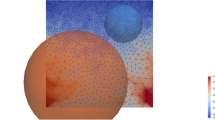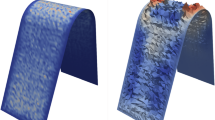Abstract
This paper aims at imposing no-penetration condition over arbitrary surfaces which act as bounding surfaces, also known as packaging constraints, on the design surface of shape optimization problem. We use Vertex Morphing technique for the shape parametrization. Vertex Morphing is a consistent surface control approach for node-based shape optimization. The suitability of this technique has been assessed and demonstrated for a wide range of engineering applications without geometric shape constraints. In this contribution, a consistent formulation is presented for the implementation of numerous point-wise geometric constraints in four main steps. First, a potential contact between optimization surface points and the bounding surface is identified via the so-called gap function. Second, the shape gradients of objective functions and active constraints are mapped onto the Vertex Morphing’s control space, where the optimization problem is formulated. Third, the linear least squares method is used to project the steepest-descent search direction onto the subspace tangent to the mapped active constraints. Finally, the feasible design update is mapped onto the geometry space. To verify the perfect consistency between the geometry space (where the constraints are formulated) and the control space (where the optimization problem is solved) two applications of CFD shape optimization in the automotive industry are presented.

















Similar content being viewed by others
References
Allaire G, Jouve F, Michailidis G (2013) Casting constraints in structural optimization via a level-set method. In: 10th World Congress on Structural and Multidisciplinary Optimization, (1):1–10
Allaire G, Jouve F, Michailidis G (2016) Thickness control in structural optimization via a level set method. Struct Multidiscip Optim 53(6):1349–1382. https://doi.org/10.1007/s00158-016-1453-y
Allaire G, Jouve F, Toader A-M (2002) A level-set method for shape optimization. Comptes Rendus Mathematique 334(12):1125–1130
Baumgärtner D, Viti A, Dumont A, Carrier G, Bletzinger K-U (2016) Comparison and combination of experience-based parametrization with vertex morphing in aerodynamic shape optimization of a forward-swept wing aircraft. In: Aeronautics AI, Astronautics (eds) 17th AIAA/ISSMO Multidisciplinary Analysis and Optimization Conference, Washington D.C.
Bletzinger K-U (2014) A consistent frame for sensitivity filtering and the vertex assigned morphing of optimal shape. Struct Multidiscip Optim 49(6):873–895
Bletzinger K-U (2017) Shape optimization. In: Stein E, de Borst R, Hughes T (eds) Encyclopedia of Computational Mechanics, 6 Volume Set, 2nd Edition, volume 2,3. Wiley
Fleissner F, Haag T, Hanss M, Eberhard P (2011) Trends in Computational Contact Mechanics, vol 58
Germanou LA, Papoutsis-Kiachagias E, Delacroix A, Giannakoglou K (2016) Defroster nozzle shape optimization using the continuous adjoint method. VII European Congress on Computational Methods in Applied Sciences and Engineering, (June):10
Guo X, Zhang W, Zhong W (2014) Explicit feature control in structural topology optimization via level set method. Comput Methods Appl Mech Eng 272:354–378
Haftka RT, Gürdal Z (eds) (1992) Elements of structural optimization. Solid mechanics and its applications. Springer, Netherlands
Hoang V-n, Jang G (2017) Topology optimization using moving morphable bars for versatile thickness control. Comput. Methods Appl. Mech. Engrg. 317:153–173
Hojjat M (2014) Node-based parametrization for shape optimal design. PhD thesis, Technische Universität München
Hojjat M, Stavropoulou E, Bletzinger KU (2014) The vertex morphing method for node-based shape optimization. Comput Methods Appl Mech Eng 268:494–513
Karpouzas G, Papoutsis-Kiachagias E, Schumacher T, de Villiers E, Giannakoglou K, Othmer C (2016) Adjoint optimization for vehicle external aerodynamics. Int J Autom Eng 7(January):1–7
Karpouzas GK, De Villiers E (2014) Level-Set Based Topology Optimization Using the Continuous Adjoint Method. (June):4–6
Keuthen M, Ulbrich M (2015) Moreau–yosida regularization in shape optimization with geometric constraints. Comput Optim Appl 62(1):181–216
Konyukhov A, Schweizerhof K (2008) On the solvability of closest point projection procedures in contact analysis: analysis and solution strategy for surfaces of arbitrary geometry. Comput Methods Appl Mech Eng 197 (33-40):3045–3056
Kopačka J, Gabriel D, Plešek J, Ulbin M (2016) Assessment of methods for computing the closest point projection, penetration, and gap functions in contact searching problems. Int J Numer Method Eng 105(11):803–833. nme.4994
Kraft D (2015) Geometric Constraints in Descent Methods for Shape Optimisation. Mathematical Modelling and Numerical Analysis
Laursen T (2003) Computational contact and impact mechanics. Springer, Berlin
Le C, Bruns T, Tortorelli D (2011) A gradient-based, parameter-free approach to shape optimization. Comput Methods Appl Mech Eng 200(9-12):985–996
Michailidis G (2014) Manufacturing constraints and multi-phase shape and topology optimization via a level-set method. PhD thesis, Ecole Polytechnique
Othmer C (2008) A continuous adjoint formulation for the computation of topological and surface sensitivities of ducted flows. Int J Numer Method Fluids 58(8):861–877. https://doi.org/10.1002/fld.1770
Othmer C (2014) Adjoint methods for car aerodynamics. J Math Industry 4(1):1–23
Othmer C, Villiers ED, Weller HG (2007) Implementation of a continuous adjoint for topology optimization of ducted flows. In: Aeronautics AI, Astronautics (eds) 18th AIAA Computational Fluid Dynamics Conference, Miami
Polyanin A, Manzhirov A (2006) Handbook of Mathematics for Engineers and Scientists. Taylor & Francis
Popp A (2012) Mortar methods for computational contact mechanics and general interface problems. PhD thesis, Technische Universitȧt Mu̇nchen
Pyzara A, Bylina B, Bylina J (2011) The influence of a matrix condition number on iterative methods’ convergence. In: 2011 Federated Conference on Computer Science and Information Systems (FedCSIS), pp 459–464
Rosen JB (1960) The gradient projection method for nonlinear programming. part i. linear constraints. J Soc Ind Appl Math 8(1):181–217
Rosen JB (1961) The gradient projection method for nonlinear programming. part ii. nonlinear constraints. J Soc Ind Appl Math 9(4):514–532
Saad Y (2003) Iterative methods for sparse linear systems. SIAM
Samareh J (2001) Survey of shape parameterization techniques for high-fidelity multidisciplinary shape optimization. AIAA J 39(5):877–884
Schmitt O, Friederich J, Riehl S, Steinmann P (2016) On the formulation and implementation of geometric and manufacturing constraints in node–based shape optimization. Struct Multidiscip Optim 53(4):881–892
Schmitt O, Steinmann P (2015) On curvature control in node-based shape optimization. Pamm 15(1):579–580
Tiwari S, Dong H, Fadel G, Fenyes P, Kloess A (2014) A physically-based shape morphing algorithm for packing and layout applications. Int J Interact Des Manuf 9(4):277–289
Wang T (2016) Development of Co-Simulation environment and mapping algorithms. PhD thesis, Technische Universität München
Xia Q, Shi T, Wang MY, Liu S (2010) A level set based method for the optimization of cast part. Struct Multidiscip Optim 41(5):735– 747
Xu S, Jahn W, Müller J-D (2014) Cad-based shape optimisation with cfd using a discrete adjoint. Int J Numer Methods Fluids 74(3):153–168
Acknowledgements
This paper is based on a part of the research sponsored by the BMW group. The authors are grateful to Dr. Stefan Zemsch, Dr. Gertraud Daschiel, Dr. Mohmoud Reza Manesh Karimi and Dr. Steffen Jahnke for providing high-fidelity models and for many fruitful discussions. The first two authors gratefully acknowledge the support of the International Graduate School of Science and Engineering (IGSSE) of the Technische Universität München, Germany, under project 9.10.
Author information
Authors and Affiliations
Corresponding author
Rights and permissions
About this article
Cite this article
Najian Asl, R., Shayegan, S., Geiser, A. et al. A consistent formulation for imposing packaging constraints in shape optimization using Vertex Morphing parametrization. Struct Multidisc Optim 56, 1507–1519 (2017). https://doi.org/10.1007/s00158-017-1819-9
Received:
Revised:
Accepted:
Published:
Issue Date:
DOI: https://doi.org/10.1007/s00158-017-1819-9




